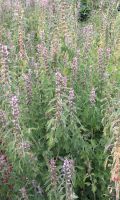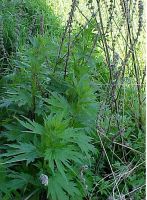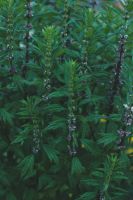Distribution: Occurring east of the Cascades crest in Washington; British Columbia to Oregon, east to Idaho and Montana; also in eastern North America.
Habitat: Disturbed ground, often in association with cities and towns where escaping cultivation.
Flowers: June-September
Origin: Introduced from Eurasia
Growth Duration: Perennial
Conservation Status: Not of concern
Pollination: Bumblebees, bees
Fibrous-rooted perennial herbs from a branched, woody base, the square, erect, clustered stems 4-15 dm. tall, with retrorse hairs on the angles.
Leaves opposite, all cauline, the lower soon deciduous, the principle leaves somewhat above the base, the blades palmately veined and cleft and again coarsely toothed, 5-10 cm. long and wide, loosely short-hairy beneath, the petiole equaling the blade; leaves reduced upward, narrower, less cleft, shorter petioles, the uppermost entire.
Flowers verticillate in the axils of reduced leaves; calyx tube firm, 5-angled, 3-4 mm. long, the 5 spine-tipped, narrow lobes equaling the tube, the 2 lower ones deflexed; corolla two-lipped, 1 cm. long, pale pink, the upper lip white-woolly, hood-like, enclosing the 4 equal stamens; the lower lip spreading, 3-lobed, the center lobe obcordate, the lateral lobes oblong; style 2-parted; ovary 2-celled, superior.
Fruit of 4, 3-sided nutlets.
Publication: Sp. Pl. 2: 584. 1753.
PNW Herbaria: Specimen records of Leonurus cardiaca in the Consortium of Pacific Northwest Herbaria database
WA Flora Checklist: Leonurus cardiaca checklist entry
OregonFlora: Leonurus cardiaca information
E-Flora BC: Leonurus cardiaca atlas page
CalPhotos: Leonurus cardiaca photos








